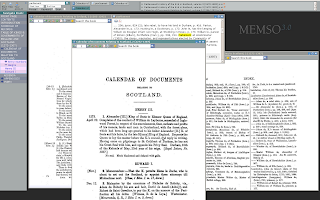In the April 2009 issue:
- Call for suggestions
- Latest publications
- Latest manuscripts
- MEMSO 3.0 - new features
- New places to find TannerRitchie: Blog, RSS feed, Facebook & Twitter
- Historians who can program: invitation to programmers to try our API.
1. Send us your suggestions for books and manuscripts to publish
TannerRitchie is looking for great new series and collections to publishing during the years 2009-2012, and we need your help!
What series would you like to see added to our collections? What series do you think would be popular with our clients and users? The only requirement for digitising printed books we have is that material is out of copyright, and within a broad definition of British medieval and early modern history. As a rule, books published by HMSO or the government are covered by Crown copyright, which expires 50 years after publication.
Alternatively, let us know of collections of manuscripts in the UK National Archives, or elsewhere in Britain, that would be a useful and popular addition to MEMSO.
Send your suggestions to office at tannerritchie dot c o m.
2. Latest publications
Register of the Privy Council, series 3: remaining volumes are being published this week, completing this huge series on which we began work in 2002!
Calendar of Letter-Books Preserved in the Archives of the Corporation of the City of London at the Guildhall: Series completed, and available for only $15 Canadian per volume.
Calendar of State Papers, Domestic, volume 1650 (1650-1650)
3. Latest Manuscripts
State Papers, Foreign, for the reign of Elizabeth I (SP 70), completed (over 21,000 images)
State Papers, France (SP 78), 1587-1631 completed (30,000 images)
Already available: State Papers, Foreign, Edward VI (SP 68), State Papers, Foreign, Mary (SP 69), State Papers, Foreign, Spain (SP 94) (total, over 34,000 images).
Collectively, these now form an incredible resource for early modern historians, and one which we intend to develop in new ways to enable increasingly easy access to these manuscripts in the future.
4. MEMSO 3.0
In the next 7 to 10 days we plan to launch version 3.0 of the MEMSO interface, introducing some major usability and speed improvements.
Key new features:
- Save books and manuscripts you use frequently to your personal bookshelf.
- Open and browse multiple books and manuscripts at once.
If there are features you'd like added to MEMSO, please let us know.
5. New places to find TannerRitchie: our Blog, RSS feed, Facebook and Twitter
TannerRitchie can now be found in a range of new places on the internet apart from our main website.
- tannerritchie.blogspot.com: News, new titles and articles about interesting material we find in MEMSO.
- RSS feeds. Subscribe to updates from the blog, or get instant notification of new titles via our RSS feed at www.tannerritchie.com/newtitlesrss.php
- Become a fan of TannerRitchie at our Facebook page: www.facebook.com/pages/TannerRitchie-Publishing/48000059684.
- Follow us on Twitter (we'll follow back) at www.twitter.com/tannerritchie. We publish a daily excerpt from MEMSO that gives an interesting snippet from the past in 140 characters or less.
6. Can you program? MEMSO has an API, would you like to use it?
If you know what an API (Application Programming Interface) is, then chances are that you know a little about programming, and the possibilities that using APIs opens up for reusing data across different websites and applications. We are now working on the first generation of a MEMSO API, which is integral to MEMSO 3.0.
We are interested in speaking to subscribers who would like to be involved in working with MEMSO data. Could you use MEMSO data on your website?
Contact roland at tannerritchie dot c o m to discuss ideas with us.


